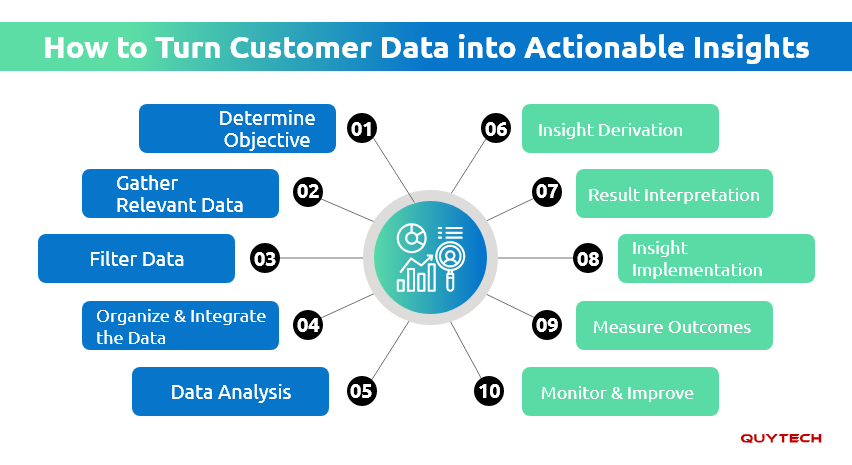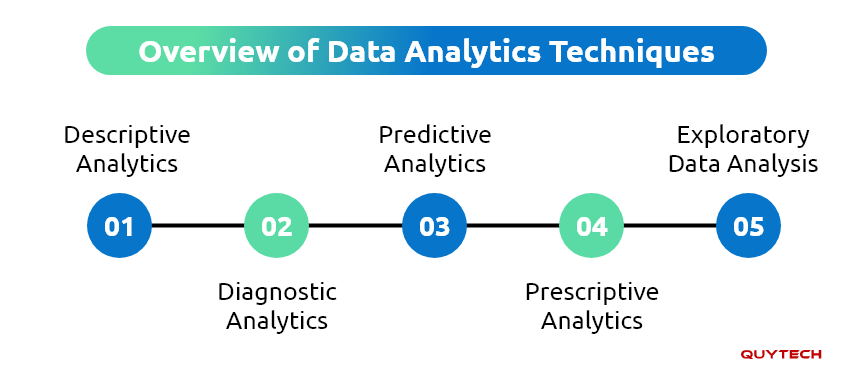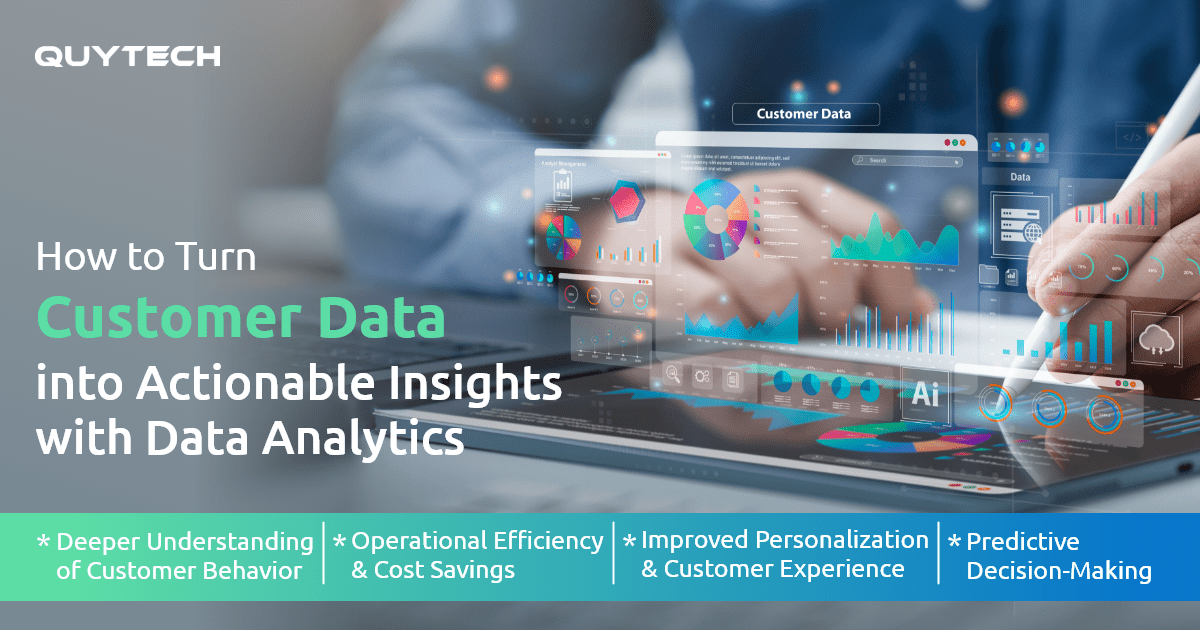A business that knows its customers never loses direction’ perfectly explains the current business landscape. In today’s customer-centric business environment, just offering quality products or services no longer suffices. What matters is if it satisfies the customers. What truly sets a business apart is its understanding of its customers’ needs and response based on that.
Customers’ perceptions and needs are not something that can be acted upon based on assumptions. It is something that should be determined by analyzing every interaction customers have with the brand. This is where customer data analytics plays a vital role. It transforms data into meaningful insights that drive better decisions and stronger relationships.
In this blog, we will discover how businesses use data analytics to generate actionable insights and how it assists them in responding to customer needs effectively.
What is Customer Data
Customer data is the key to following a customer-centric business approach. It includes all the information, like the customer’s preferences, buying habits, demographics, interactions with the brand, etc. This data helps a business know its customers better and deliver a personalized experience to them.
Many businesses have a large volume of customer data but still fail to satisfy their target audience. This happens because simply collecting the data cannot help the business to grow. Customer data is of use only when you analyze it to gain better insights and directions, which can be done with the help of data analytics.
Why Customer Data Analytics Matters
We are no longer in the era of using experience and intuition to guess what the customers need. Data analytics does it all. Reaching a value of $ 24.2 billion by 2025, the global customer data analytics market points in the same direction.
Customer data analytics provides businesses with the right direction towards understanding customers at different levels. Proven by Industry reports, which indicate a strong vertical-wise adoption of customer data analytics, with retail commanding 21% of the customer analytics market revenue in 2024. The healthcare sector is also projected to witness the fastest growth with a CAGR of 22.5% through 2030.
Customer data analytics works by turning data into actionable insights. This data is collected from the activities and interactions of the customers themselves, so it is considered a reflection of their point of view. When businesses understand the perception of the customers, they can grasp customer expectations and direct their performance accordingly.
Types of Customer Data You Can Analyze with Data Analytics

Data analytics enables businesses to collect and segregate data based on its nature for further analysis. The following are the types of customer data that can be analyzed:
Demographic Data
Demographic data refers to the data that describes who your customers are. These include age, gender, occupation, income level, education level, etc. It helps businesses to customize their product or service to their target audience and cater to their needs.
Behavioral Data
As the name suggests, behavioral data refers to one that defines the activity of the customers when they interact with your brand, whether online or offline. It covers website navigation patterns, in-store visit frequency, walk-in patterns, carts, wishlists, product browsing behavior, etc. The data collected through this helps businesses in optimizing their product or service to serve their customers’ intent and interests.
Transactional Data
The transactional data consists of information like the order history, average value of an order, purchase frequency, data related to refund or return, etc. Transactional data assists businesses in identifying the most valuable customers, predicting their future purchases, and spotting product performance trends.
Psychographic Data
The psychographic data uncovers the reason behind the purchase behavior of the customers. It covers their values, beliefs, personality traits, hobbies, interests, lifestyle choices, etc. This data enables the business to connect to its customers on an emotional level and personalize the messaging and face-to-face conversations based on their vibe.
Engagement Data
The engagement data defines how the customer is engaging with the brand across various platforms. These include social media interactions, verbal feedback, offline event participation, on-website engagement, reviews, and shares etc. This helps a business identify the effectiveness of campaigns and other engagement segments.
Geographic Data
The geographic data determines the location of the customers. It includes the country, zip codes, regions, time zones, etc. Hyper-targeted marketing, content translation, regional campaign planning, and inventory or shipping optimizations are all aided by geographic information.
Customer Support Data
Customer support data is the information collected through help desks, tickets, customer service calls, face-to-face queries, and chats. This data helps the business to analyze the common issues raised by customers and the resolution satisfaction rates.
Customer Feedback & Sentiment Data
The customer feedback and sentiment data are the information collected through social media tags and reviews, ratings, customer testimonials, verbal feedback, suggestion box, sentiment analysis, etc. This data helps businesses to know the customer’s point of view of their brand.
How to Turn Customer Data into Actionable Insights:

Customer data analytics is not conducted by simply collecting data and making decisions. The following steps define the procedure for collecting and turning data into insights:
1. Determine Objective
The first step in customer data analytics is to determine the objective. Here, you identify the areas that you want to improve. It could be reducing customer churn, enhancing customer loyalty, improving the engagement matrix, etc. With a clear understanding of the objective, it is easy to stay on track.
2. Gather Relevant Data
After determining the objective, start collecting raw data from different sources. This data can be obtained through internal databases, help tickets raised, customer support forums, online reviews, ratings, social media mentions, etc. While collecting data, keep in mind that it should be relevant to your objective.
3. Filter Data
Raw data collected from varied sources is not ready for analysis. The data needs to be cleaned so that there are no errors, missing values, inconsistencies, or irrelevancies in it. This will help in getting more accurate results, as unfiltered data can give misleading results.
4. Organize and Integrate the Data
Data is often scattered across multiple departments and systems. Every department has its own collection of data related to the customers. Organizing and integrating data involves combining all the data obtained through every department and linking them in one system.
5. Data Analysis
After the data has been organized and integrated, the main step of data analysis begins. In this step, some data gets analyzed with basic statistical analysis, while complex data gets analyzed by artificial intelligence, machine learning, clustering, trend analysis, etc.
6. Insight Derivation
After depicting patterns from the data, these patterns are used to derive insights. These insights can help in highlighting the areas where the business is lacking in providing customer satisfaction, and also those areas where it excels. With the help of AI, dashboards are created to offer meaningful insights to the decision-makers.
7. Result Interpretation
After deriving insights, the technical results are interpreted into strategic findings. This is done by highlighting the reasons behind any activity related to the customers. It creates a link between the findings and how it affects the business. It provides context to the results, which gives a track to follow and work on.
8. Insight Implementation
Insight implementation is the stage where planning meets execution. In this step, the insights derived are worked upon by making suitable business decisions that work on and target the right areas. These could be related to the product, service, customer support, brand image, etc.
9. Measure Outcomes
After the implementation process, the next step is to see if the actual performance matches the planned performance. This step determines if the strategy execution is successful or not. It creates a feedback loop to make changes based on the outcomes.
10. Monitor and Improve
Post measuring outcomes, the next step is to monitor and improve the performance. The business environment is dynamic, and to keep up with this dynamic environment, business strategies need to be improvised over time. This keeps the business up to date, and solutions are based on data and not on intuition.
Benefits of Customer Data Analysis for Actionable Insights
Analytics provides a business with actionable insights from data that help it make informed business decisions. The following are some benefits of using customer data analytics:
Deeper Understanding of Customer Behavior
Utilizing customer data analytics allows you to understand your customers at a deeper level. It helps you understand their emotion, intent, interests, lifestyle choices, etc., which gives you insight into their likes and dislikes and helps you perform better.
Improved Personalization and Customer Experience
Customer data analytics helps in differentiating your customers based on their interests, which can then be used to offer them a more personalized experience. This makes the customers feel valued and enhances the customer experience.
Operational Efficiency and Cost Savings
Customer data analytics shows the well-performing areas and pinpoints the low-performing ones. This enables businesses to identify the areas of deviation and improve them. Additionally, it identifies segments that no longer provide value, assisting companies in reducing wasteful spending by diverting resources from activities that aren’t working.
Stronger Customer Retention
When customer data is analyzed, it can help in detecting early signs of disengagement. It helps businesses to proactively start engagement and loyalty campaigns and improve the customer’s interaction experience. This helps in reducing customer churn and increasing loyalty and retention.
Predictive Decision-Making
Customer data analytics is a process that is both forward-looking and backward-looking. It counts experience and past data as well as forecasts future actions. It utilizes predictive analysis and AI models for future forecasting to act proactively.
Smarter Product Development
With the data collected through different sources and analysis made with the help of data analytics, a business can work on its product or services in a way that satisfies its audience. Apart from insights on existing drop-offs, it also highlights the additional features or quality-related customer expectations for the businesses to work on.
Read More: AI Agents in Customer Service: Benefits, Use Cases, Real-World Examples, and More
Making Sense of Raw Data: The Power of Analytics
If you’ve ever gone through raw data collected from varied sources, you will come across the fact that it makes no sense. Then, how do businesses use this data to make significant decisions for their products and services? The answer is Data analytics. Data analytics transforms this meaningless, unstructured data and scattered data into meaningful insights. Businesses utilize these insights and make informed decisions.
Data analytics helps in deriving various insights that are often not similar in nature. Even the data analyzed is not similar, as it can be numbers, clicks, stamps, words, etc.
Overview of Data Analytics Techniques

Depending on the business objective and type of data, data analytics employs a variety of approaches, each with a distinct function:
Descriptive Analytics
Descriptive data analytics focuses on summarizing the historical data to explain what has happened. It simply highlights the occurrence of an incident and gives the data related to it.
Diagnostic Analytics
Diagnostic analytics focuses on uncovering the reason and answering why it happened. It determines the reason by analyzing the data, patterns, and their interrelationships.
Predictive Analytics
After knowing the incident and its reason, predictive analysis comes in to predict the effects that the incident is gonna reflect in the future. It utilizes AI models and machine learning to forecast
Prescriptive Analytics
Prescriptive analytics is a more advanced step than predictive analytics. It suggests a suitable course of action that the business can take to tackle future challenges. This helps businesses to act proactively.
Exploratory Data Analysis
Exploratory data analytics works by discovering data without a pre-decided objective. It often unleashes unexpected data patterns, trends, and interrelationships as it does not follow a track while exploring.
Real-Time vs. Historical Data Analytics
| Real-Time Data Analytics | Historical Data Analytics |
| Real-time data analytics emphasizes analyzing the data as it is generated. | Historical data analytics works by analyzing the already existing historical data. |
| It helps give solutions promptly without any delay. | It focuses on giving solutions for strategy formation. |
| Assists in cases like fraud detection, live support, etc. | Assists in cases like sales pattern and trend analysis, customer segmentation, etc. |
Challenges Businesses Face in Customer Data Analytics
Data Privacy and Compliance
With the rise in data-related safety regulations, collecting, organizing, and analyzing data has become quite complex. Adherence to these regulations is mandatory and comes with respective penalties as well. While following data security guidelines is beneficial, the challenge comes in personalizing the experience of customers when there are privacy considerations.
Data Silos and Integration Issues
Customer data is acquired differently in different departments and is scattered across them. This leads to the formation of data silos that hinder the organization to view the customer experience from a unified perspective. Integration becomes challenging due to technical differences between departments, and the decision isn’t made at its best.
Lack of Skilled Resources
Data analytics is not just about handling the software; it requires skills as well. Many organizations lack a skilled workforce to conduct data analysis, while many may lack the material resources. Without the right balance of skilled personnel and the right tools, conducting effective analysis can be a challenge.
Read More: How AI-Powered Chatbots Improve Customer Service in Retail?
How Quytech Can Help You Leverage Customer Data Analytics
Quytech’s expertise in providing custom analytics solutions is what makes us stand out from the crowd. Our quality-rich, customized data analytics solution helps you gain a competitive edge by utilizing historical as well as real-time data.
With experience in the domains of technology and artificial intelligence, gaining smart insights with data can be a breeze. Quytech combines extensive knowledge with strong resources to assist you in making data-driven, well-informed decisions. Our track record of achievement and client testimonials attest to the practical applications of our solutions.
Conclusion
In the data-rich environment we have at present, businesses have convenient access to the customer perspective. With advanced tools and techniques like artificial intelligence and data analytics, adapting to customer expectations becomes easy.
Whether you need to analyze data in real-time or utilize it to make decisions for the long term, data analytics makes it possible both ways. With benefits like enhanced customer understanding, retention, personalization, cost-effectiveness, and predictive analytics for decision-making, data analytics allows businesses to work and grow strategically.
FAQs
AI contributes to enhancing data analytics by detecting patterns, audience segmentation, predictive analytics, and improving accuracy. It speeds up the process of analysis without compromising the accuracy.
No, customer data analytics is beneficial for every small, medium, and large enterprise. It is beneficial for every organization that operates with a customer-oriented approach.
Yes, you can integrate data analytics with your existing CRM or ERP systems. A modern analytics platform can seamlessly integrate by utilizing APIs, data connectors, etc.
Predictive analytics utilizes AI models and machine learning to understand the existing data patterns, trends, and variations to forecast future outcomes based on that.



